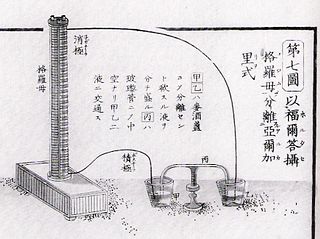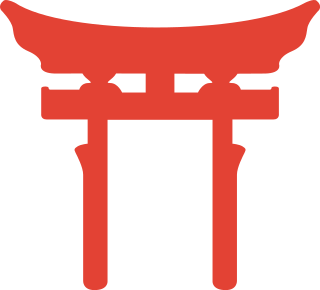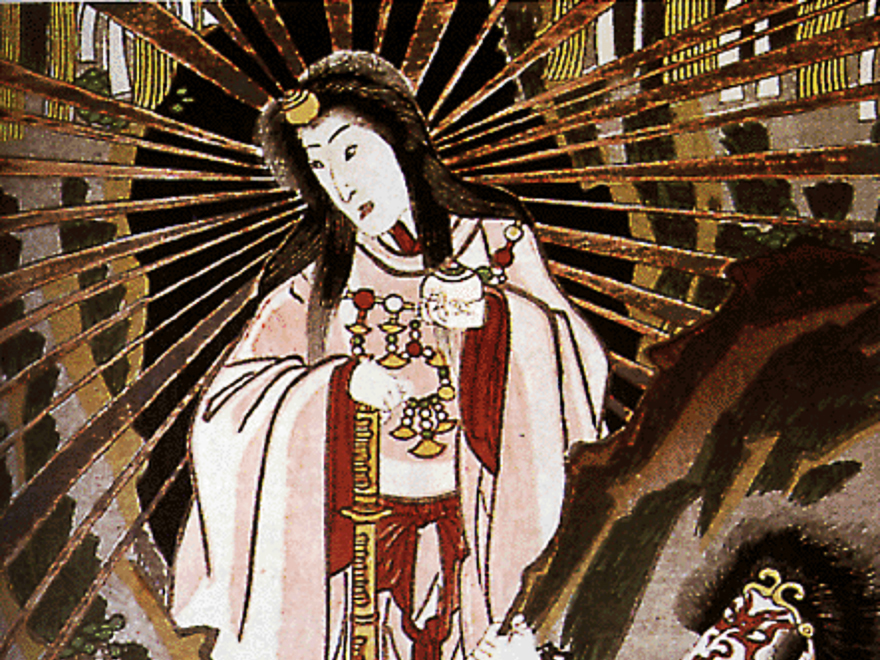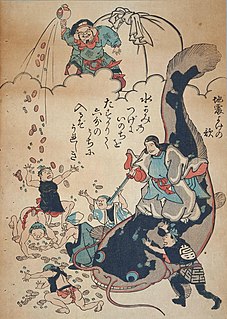
Furigana is a Japanese reading aid, consisting of smaller kana or syllabic characters, printed either above or next to kanji or other characters to indicate their pronunciation. It is one type of ruby text. Furigana is also known as yomigana (読み仮名) and rubi in Japanese. In modern Japanese, it is usually used to gloss rare kanji, to clarify rare, nonstandard or ambiguous kanji readings, or in children's or learners' materials. Before the post-World War II script reforms, it was more widespread.
Japanese is an East Asian language spoken by about 128 million people, primarily in Japan, where it is the national language. It is a member of the Japonic language family, and its ultimate derivation and relation to other languages is unclear. Japonic languages have been grouped with other language families such as Ainu, Austroasiatic, Korean, and the now-discredited Altaic, but none of these proposals have gained widespread acceptance.
Katakana is a Japanese syllabary, one component of the Japanese writing system along with hiragana, kanji and in some cases the Latin script. The word katakana means "fragmentary kana", as the katakana characters are derived from components or fragments of more complex kanji. Katakana and hiragana are both kana systems. With one or two minor exceptions, each syllable in the Japanese language is represented by one character or kana, in each system. Each kana represents either a vowel such as "a" ; a consonant followed by a vowel such as "ka" ; or "n", a nasal sonorant which, depending on the context, sounds either like English m, n or ng or like the nasal vowels of Portuguese or Galician.

Space Battleship Yamato is a Japanese science fiction anime series produced and written by Yoshinobu Nishizaki, directed by manga artist Leiji Matsumoto, and produced by Academy Productions.. The series aired in Yomiuri TV from October 6, 1974 to March 30, 1975, totaling up to 26 episodes. It revolves around the character Susumu Kodai and an international crew from Earth, tasked during an interstellar war to go into space aboard the space warship Yamato, derived from the World War II battleship of the same name, in response to a message of aid from the planet Iscandar in order to retrieve a device which is able to reverse the radiation infecting Earth after being bombed by the Gamilas (Gamilons).

Kanji are a set of logographic characters from Chinese script which forms a major part of the Japanese writing system alongside with Japanese syllabic scripts hiragana and katakana. The Japanese term kanji for the Chinese characters literally means "Han characters". It is written with the same characters as in traditional Chinese to refer to the character writing system, hanzi (漢字).

Shiritori (しりとり) is a Japanese word game in which the players are required to say a word which begins with the final kana of the previous word. No distinction is made between hiragana, katakana or kanji. "Shiritori" literally means "taking the end" or "taking the rear".

The Kofun period is an era in the history of Japan from about 300 to 538 AD, following the Yayoi period. The Kofun and the subsequent Asuka periods are sometimes collectively called the Yamato period. This period is the earliest era of recorded history in Japan, but studies depend heavily on archaeology since the chronology of historical sources tends to be distorted.

Kojiki, also sometimes read as Furukotofumi or Furukotobumi, is an early Japanese chronicle of myths, legends, hymns, genealogies, oral traditions, and semi-historical accounts down to 641 concerning the origin of the Japanese archipelago, the kami (神), and the Japanese imperial line. It is claimed in its preface to have been composed by Ō no Yasumaro at the request of Empress Genmei in the early 8th century (711–712), and thus is usually considered to be the oldest extant literary work in Japan. The myths contained in the Kojiki as well as the Nihon Shoki (日本書紀) are part of the inspiration behind many practices. Later, they were incorporated into Shinto practices such as the misogi purification ritual.

The Nihon Shoki (日本書紀), sometimes translated as The Chronicles of Japan, is the second-oldest book of classical Japanese history. The book is also called the Nihongi. It is more elaborate and detailed than the Kojiki, the oldest, and has proven to be an important tool for historians and archaeologists as it includes the most complete extant historical record of ancient Japan. The Nihon Shoki was finished in 720 under the editorial supervision of Prince Toneri and with the assistance of Ō no Yasumaro dedicated to Empress Genshō.

Himiko, also known as Shingi Waō, was a shamaness-queen of Yamatai-koku in Wakoku (倭国). Early Chinese dynastic histories chronicle tributary relations between Queen Himiko and the Cao Wei Kingdom (220–265) and record that the Yayoi period people chose her as ruler following decades of warfare among the kings of Wa. Early Japanese histories do not mention Himiko, but historians associate her with legendary figures such as Empress Consort Jingū, who was regent in roughly the same era as Himiko.

Japanese mythology is a collection of traditional stories, folktales, and beliefs that emerged in the islands of the Japanese archipelago. Shinto and Buddhist traditions are the cornerstones of Japanese mythology. The history of thousands of years of contact with China, Korea, Ainu, and Okinawan myths are also key influences in Japanese mythology.

Ajisukitakahikone is a kami in Japanese mythology.

Phoenix is an unfinished manga series by Osamu Tezuka. Tezuka considered Phoenix his "life's work"; it consists of 12 books, each of which tells a separate, self-contained story and takes place in a different era. The plots go back and forth from the remote future to prehistoric times. The story was never completed, having been cut short by Tezuka's death in 1989. Several of the stories have been adapted into anime series and OVAs, and a live-action movie. As of 2007, the entire manga series is available in English-language translations.
The word Japan is an exonym, and is used by many languages. The Japanese names for Japan are Nippon and Nihon. They are both written in Japanese using the kanji 日本.
Yamatai-koku or Yamato-koku (邪馬台国)(c. 1st century –c. 3rd century) is the Sino-Japanese name of an ancient country in Wa (Japan) during the late Yayoi period (c. BC 1,000 –c. 300 CE). The Chinese text Records of the Three Kingdoms first recorded as Yamatai guo or Yemayi guo as the domain of Priest-Queen Himiko (卑弥呼). Generations of Japanese historians, linguists, and archeologists have debated where Yamatai-koku was located and whether it was related to the later Yamato (大和国).

Yamato Takeru, originally Prince Ousu, was a Japanese semi-legendary prince of the Yamato dynasty, son of Emperor Keikō, who is traditionally counted as the 12th Emperor of Japan. His name written in kanji can vary, in the Nihon Shoki it is spelled 日本武尊 and in the Kojiki it is 倭建命.

Nara is the capital city of Nara Prefecture, Japan. As of 1 April 2019, Nara has an estimated population of 359,666, making it the largest city in Nara Prefecture and sixth-largest in the Kansai region of Honshu. Nara is a core city located in the northern part of Nara Prefecture bordering the Kyoto Prefecture.

Waka is a type of poetry in classical Japanese literature. Although waka in modern Japanese is written as 和歌, in the past it was also written as 倭歌, and a variant name is yamato-uta (大和歌).

Takemikazuchi (建御雷/武甕槌) is a deity in Japanese mythology, considered a god of thunder and a sword god. He also competed in what is considered the first sumo wrestling match recorded in history.

Kyushu dynasty theory is a theory that there was a dynasty representing Japan in Kyushu until the end of the 7th century, and that Dazaifu was its capital city.















